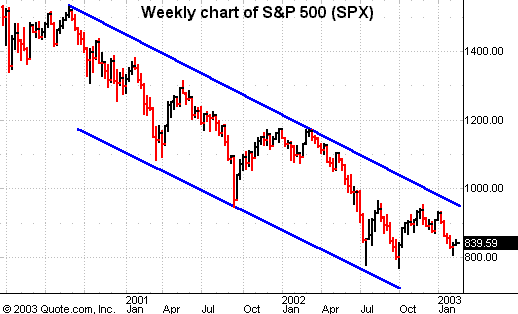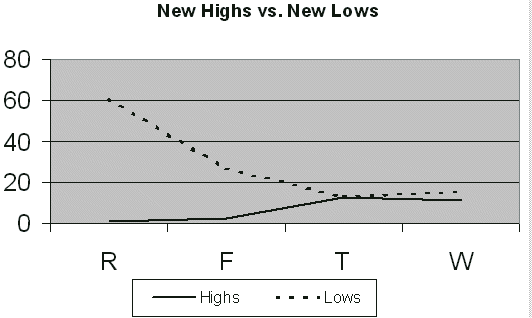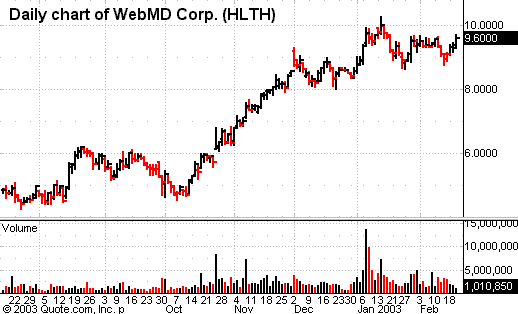Update On The Iraq Saga
Sorry to say, the market situation
remains the same — most investors are waiting to see what develops
geopolitically before committing any major assets to equities in any
direction. And who can blame them? The international soap-opera continues.
Blix’s report, if you saw it, was diplomacy designed to
give both sides of the war debate some ammunition, but not really answer any
question definitively. He should be a Fed board governor! France, Germany,
China, and Russia have used the lack of smoking gun to try and delay US action.Â
France, wanting to be the leader of new Europe, has chewed out all the rest of
Europe outside of Germany and Belgium for being so bold as to express their
opinion in support of the US. However France, Germany, and Belgium did finally
acquiesce to the wishes of the other 16 members of NATO and allowed more missile
defense for Turkey. Turkey meanwhile has used its legislature approval process
to try and get more money out of the US (for the second time now) before
allowing full use of Turkey as an attack zone.Â
Meanwhile evidence from a German trial, combined with
Israeli tracking of funds going through Iraq’s Rafidain Bank, leaves little
doubt that Iraq is not only blatantly violating UN sanctions banning the flow of
funds from Iraqi government and companies, but is also funding terrorists aiming
at Israel consistently, and is likely to have partially funded the money used by
the cells responsible for 9/11. Many intelligence agencies believe Iraqi
intelligence helped design and implement the 9/11 attack, though this is the
first public information that confirms the likelihood that they helped finance
it, as maintained by Israeli and US intelligence for some time. Unfortunately
those who oppose attack are not yet taking Saddam’s threat and violations
seriously enough to propose a strong enough containment or policy to
legitimately offer an alternative to war.
So while the case against Saddam grows, international drama
will likely delay the attack into mid March or later. Unfortunately this likely
means more whipsaw action and drifting by the market until there is a true
resolution. Gold took a big dip from the potential stalling of war, currencies
corrected somewhat, but crude oil just kept moving higher. Commodity indexes
are consolidating, and commodity currencies are making new highs against the
dollar. Global bonds are approaching new highs, while US bonds lag them only a
bit. Many European bourses have fallen below last October’s lows, and US stocks
are drifting toward this critical support zone.
I continue to advocate that investors NOT try and
PLAY the
war in any way financially. Those who must hedge because they cannot liquidate
major positions that would be affected by war should consider some hedging via
crude puts in the event of a positive war outcome, and to hedge a negative war
outcome via leap puts on oil sensitive, consumer sentiment sensitive, and
bellwether stocks as well as calls on global short-rates. The cost of this
insurance is high and growing though, and high levels of cash are preferred.
Therefore investors should keep a mix of cash in various
currencies (Everbank.com) and sit on their hands mostly until the global
showdown develops some clarity.Â
Once war-jitters recede and the outlook is less risk-prone,
we believe the market will launch a strong and more sustained move — though we
don’t yet know in which direction.  Watch and wait for
volume, breadth,
leadership, and follow-through to emerge in one direction before allocating
serious capital to either the short or long side. Caution is still advised. It
is frustrating to be so long and so heavily on the sidelines, but that’s better
than getting chewed up in the markets in a not-very-positive market
environment. It’s better to have indicators that tell when the environment
isn’t very good.
Since March 2000
the world index is down over 45%, the S&P over 48%, the IBD mutual fund index is
down over 62%, and the Nasdaq has crashed over 76%. Meanwhile since March
2000 the long/short strategy we summarize and follow-up each week in this column
has made more than 39% on a worst drawdown of under 6%.While
this performance is certainly underperforming our long-term growth rate, and it
is hardly thrilling to have been so heavily in cash since March of 2000, we have
managed to eke out gains with very low risk in a very dangerous market
environment where 9 out of 10 traders have been big losers.Â

Our official model portfolio overall allocation remains
VERY DEFENSIVE. We’re now 84% in T-bills awaiting new opportunities, with one
sole long position. Our model portfolio followed up weekly in this column was
up 41% in 1999, up 82% in 2000, up 16.5% in 2001, and up 7.58% in 2002, an
average annual gain of over 36% — all on a worst drawdown of around 12%.
We’re now up 0.02% for the year 2003.  Â
To our daily
Top RS/EPS New Highs list the entire rally from the 7/24 and then October
lows never even registered on the radar screen having mustered up just ONE solid
week of consistent +20 or higher readings since 7/24. Bottom RS/EPS New
Lows list did rise above 20 new lows daily the week before last, signaling a
downward bias. However new lows were not over 20 consistently this week.Â
We had readings of 1, 2, 14, and 11 last week in our Top RS/EPS New Highs
list, accompanied by just 6 breakouts of a 4+ week range and one close call
(
GRMN |
Quote |
Chart |
News |
PowerRating). Bottom RS/EPS New lows fell somewhat last week with readings of 61, 27, 13, and
15, accompanied by just 5 breakdowns of 4+ week patterns and no real close call
on the short side.Â

For those not familiar with our long/short strategies, we
suggest you review my book
The Hedge Fund Edge, my course “The Science of Trading,”
my video seminar, where I discuss many new techniques, and my latest
educational product, and
interactive training module. Basically, we have rigorous criteria for
potential long stocks that we call “up-fuel,” as well as rigorous criteria for
potential short stocks that we call “down-fuel.” Each day we review the list of
new highs on our “Top RS and EPS New High List” published on TradingMarkets.com
for breakouts of four-week or longer flags, or of valid cup-and-handles of more
than four weeks. Buy trades are taken only on valid breakouts of stocks that
also meet our up-fuel criteria. Shorts are similarly taken only in stocks
meeting our down-fuel criteria that have valid breakdowns of four-plus-week
flags or cup and handles on the downside.Â
In the US market, continue to only
buy or short stocks in leading or lagging industries according to our group and
sub-group new high and low lists. We continue to buy new signals and sell short
new short signals until our portfolio is 100% long and 100% short (less
aggressive investors stop at 50% long and 50% short). In early March of 2000, we
took half-profits on nearly all positions and lightened up considerably as a sea
change in the new-economy/old-economy theme appeared to be upon us. We’ve been
effectively defensive ever since.
Upside breakouts meeting up-fuel criteria (and still open
positions) so far this year are: Port Financial
(
PORT |
Quote |
Chart |
News |
PowerRating) @40.99 (47.76)- w/Â a 43 ops to
lock in profits, and WebMD
(
HLTH |
Quote |
Chart |
News |
PowerRating) @9.44 (9.38) w/ an 8.5 ops. Continue to watch
our NH list and buy flags or cup-and-handle breakouts in NH’s meeting our
up-fuel criteria — but be sure to only add names that are in leading groups,
and now only add two trades per week once again until leadership and
follow-through improve.Â


On the short side this year, we’ve had breakdowns from
flags (one can use a down cup-and-handle here as well) in stocks meeting our
down-fuel criteria (and still open positions) in NONE. Continue to watch our NL
list daily and to short any stock meeting our down-fuel criteria (see
interactive training module) breaking down out of a downward flag or down
cup-and-handle that is in a leading group to the downside but only add up to two
in any week (and only in the weakest groups) until we get better breadth numbers
on the downside and better leadership.
There will be lots of good opportunities in the stock
market this year.  However right now opportunities with good reliability and
risk/reward are fairly limited. Wait for the fruit to ripen before eating it.Â
Later in the year we should have a better vantage point and clearer picture of
economic fundamentals and earnings potential.  Until then keep your powder
pretty dry. Profits can come VERY QUICKLY when things all line up correctly —
like the nearly 50% gain we took from the late ’99-early 2000 three months. But
patience is required to not give our big gains back in a less-than-optimal
period. Â
Mark Boucher
